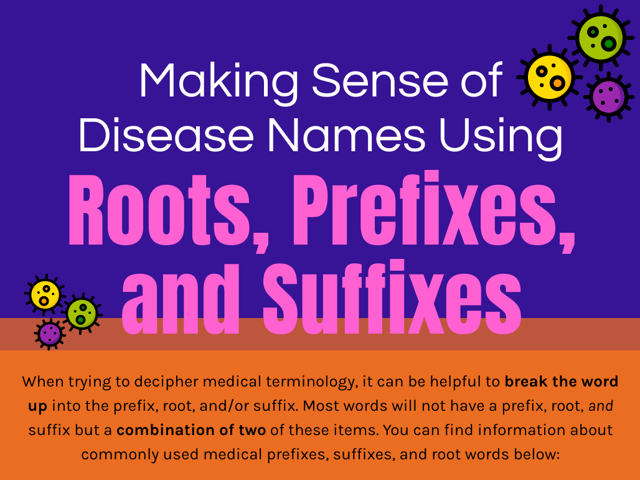
Making Sense of Disease Names Using Roots, Prefixes, and Suffixes
Medical terminology can seem like a foreign language for Certified Nursing Assistants (CNAs) who are just beginning their careers. However, a solid understanding of roots, prefixes, and suffixes can demystify this language, making it easier to comprehend and remember disease names. Let’s dive into the world of medical terminology.
The Structure of Medical Terms
Medical terms can often appear cryptic and intimidating, primarily due to their length and complexity. However, they are constructed using a fairly straightforward methodology: a combination of prefixes, roots, and suffixes. Each component plays a specific role and contributes to the overall meaning of the term.
The root usually indicates the body part or system involved, the prefix modifies the root’s meaning, providing more specific information, while the suffix describes a state, condition, disease, or procedure.
Take the term cardiomyopathy as an example. Cardio- is the root, referring to the heart; -myo- serves as a linking or combining vowel often added for pronunciation; and -pathy is the suffix, indicating a disease. Thus, cardiomyopathy is a disease of the heart muscle.
Demystifying Root Words and Their Meanings
Root words are the backbone of medical terminology, providing the central meaning of a term. They often, but not always, denote a specific body part or function. For instance, hepat refers to the liver, nephr to the kidney, and oste to bone.
By recognizing and understanding these root words, you can interpret the core of many medical terms, even if you’re not familiar with the whole word. For example, if you know the root cardi refers to the heart, you could deduce that any term containing this root, such as cardiology or cardiogram, pertains to the heart.
The Power of Prefixes in Medical Terms
Prefixes are crucial components that precede the root word, altering or enhancing its meaning. They can indicate a multitude of details such as location, quantity, timing, or status.
For instance, hypo- refers to something that is under or below the normal quantity or function; poly- refers to many or much; pre- signifies before. By comprehending prefixes, you get a clearer picture of the medical term’s context.
Consider hypoglycemia. The prefix hypo- indicates something is below normal, and the root -glyc- refers to sugar. Consequently, hypoglycemia refers to a condition where blood sugar levels are lower than normal.
Understanding Suffixes and Their Role in Medical Terms
Suffixes are appended to the end of the root words and provide critical information about a condition, disease, or procedure. Some examples include -itis indicating inflammation, -ectomy referring to surgical removal, and -osis meaning an abnormal condition or disease.
For instance, in the term appendicitis, you can infer from the suffix -itis that it relates to an inflammation. Combined with the root append-, which pertains to the appendix, appendicitis can be understood as an inflammation of the appendix.
By equipping yourself with the knowledge of how medical terms are structured and understanding common roots, prefixes, and suffixes, you can significantly enhance your understanding of medical terminology. This is a crucial skill for any CNA, as it improves communication, aids in providing high-quality patient care, and boosts professional development.
Breaking Down Parts of Disease Names
So breaking complex terms into their core components - prefixes, roots, and suffixes - can make their meanings much clearer. What does that look like in practice? To illustrate this concept, let’s examine a few examples in the table below. Each word is divided into its constituent parts, and the meanings of these parts are explained. By combining these individual meanings, we can decipher the overall definition of each term. This method of breaking down medical terminology not only simplifies these complex words but also aids in the understanding of new terms you may encounter in the future.
| Word | Prefix | Root | Suffix | Meaning |
|---|---|---|---|---|
| Adipsia | A- (without) | -dipsia (thirst) | Symptom where the patient has no thirst sensation |
|
| Angiography | Angio (blood vessels) |
-graphy (recording) |
An x-ray of the blood vessels |
|
| Aphasia | A- (without) | -phasia (speech) | Symptom of being unable to speak |
|
| Bradycardia | Brady- (slow) | Cardi (heart) | Slow heart rate | |
| Cyanosis | Cyan (blue) | -osis (condition) | Condition characterized by bluish shin |
|
| Dysphagia | Dys- (difficult) | -phagia (swallow) | Symptom of difficulty swallowing |
|
| Encephalocele | Encepha (brain) | -cele (herniation) | Protrusion of the brain through the skull |
|
| Gastritis | Gast (stomach) | -itis (inflammation) | Inflammation of the lining of the stomach |
|
| Hematuria | Hema (blood) | -uria (urine) | Symptom of blood in the urine |
|
| Hemiplegia | Hemi- (half) | -plegia (paralysis) | Paralysis of one side of the body |
|
| Hyperlipidemia | Hyper- (excessive) |
Lip (fat) | -emia (blood condition) |
Condition of too much fat in the blood |
| Nephrectomy | Nephr (kidney) | -ectomy (surgical removal) |
Surgical prodedure where the kidney is removed |
|
| Osteosclerosis | Osteo (bone) Sclero (hardening) |
-osis (condition) | A condition of abnormal hardening of the bone |
|
| Otitis | Ot (ear) | -itis (inflammation) | Infection and inflammation of the ear |
|
| Pneumonia | Pneumo (lung) | -ia (condition) | Infection of the lung |
|
| Pre-carcinogenic | Pre- (before) | Carcin (related to cancer) |
-genic (causing) | Something capable of causing future cancer |
| Scleroderma | Sclero (hardening) |
Disease involving hardening of the skin and connective tissues |
||
| Tachypnea | Tachy- (fast) | -pnea (breathing) | Fast breathing | |
| Thoracoscopy | Thoraco (chest) | -scopy (visual examination) |
Procedure involving visual examination of the chest cavity |
|
| Thrombolysis | Thrombo (clot) | -lysis (destruction of) |
Treatment to dissolve and destroy clots |
|
| Vasculopathy | Vasculo (blood vessels) |
-pathy (disease) | A disease of the blood vessels |
Practice Makes Perfect
Mastering medical terminology can seem daunting at first, but with consistent practice and application, it becomes much more manageable. Just like learning a new language, the key is immersion and repetition. Using educational tools like flashcards, quizzes, and interactive games can transform the learning process from a chore into an engaging activity. These techniques can help reinforce your memory and quicken your recall of various terms.
Additionally, actively engage with medical terms in your daily routines. Whenever you come across a new term, take a moment to break it down into its root, prefix, and suffix, and then try to understand its meaning. Look for opportunities to use these terms, such as in reports or discussions with colleagues.
Consider joining study groups or online forums where you can interact with other learners or professionals in the field. These interactions offer excellent opportunities to learn from others, test your understanding, and even teach, which further solidifies your grasp of the material.
Remember, learning is a journey, and every step you take towards understanding medical terminology better equips you to excel in your role as a Certified Nursing Assistant. Over time, with practice and patience, you’ll find yourself deciphering even the most intricate terms with ease, enhancing both your confidence and competence in your professional practice.
Keep Reading

Certified Nursing Assistant Exam Blog
How Long Does it Take to Become a CNA?
As a profession on the frontline of healthcare, Certified Nursing Assis…

Certified Nursing Assistant Exam Blog
How to Do Well on the CNA Skills Test
Over 1.3 million nursing assistants work in our healthcare system today…

Certified Nursing Assistant Exam Blog
What Does a Nursing Assistant (CNA) Do?
Are you interested in exploring medical careers? The healthcare industr…